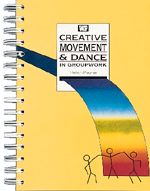 by Helen Payne, MPhil in Dance Movement Therapy
by Helen Payne, MPhil in Dance Movement Therapy
A strong link exists between movement and emotion. This innovative book provides 180 practical and stimulating activities which explore that link and includes a clear rational for the use of dance movement to enrich therapy programs.
Full Description:
Here are 180 new and stimulating activities for creative movement and dance. This practical and imaginative manual will help you lead effective and enjoyable groupwork sessions These tried and tested activities accompany good, pragmatic advice on how to prepare and evaluate a program. Vivid sample sessions and concise guidelines are also given. Helen Payne has speccifically designed this manual to help users improve their practice as well as enhance the work of those already using movement. It will be a source of encouragement to all, including those new to the discipline. Sample Activity: Body Boundary 3 Aims: To give and receive peer attention; to develop trust, sensitivity and awareness of self affecting others Population: Adolescents, adults Conditions: Safety rules Time: 10 minutes Equipment: None Structure: Pairs, whole group
Activity - All stand in a circle
- Pummel all soft areas of own body and chest (making sound).
- Pair up, one partner pummels with loose fists the other's calves, thighs, buttocks, backs, shoulders, upper arms.
- Finish by stroking from the top of their head down to their feet slowly in one gentle sweep.
- Repeat with a new partner (ie person on other side of you in the circle).
- Notice the difference in contact between the two people who have massaged you. Notice your responses to them and any differences.
Supplementary development of activity - After the above, open up a large group discussion which encourages each person to give feedback to those who massaged them.
- Ask how it felt to be getting and giving this kind of attention from each other.
Additional outcomes
A recognition of the part physical contact plays in their lives. A new level of relationship with peers. The ability to give and receive feedback from peers. Giving and receiving attention in a group.
268 pages; 8 X 9;spiral bound
ISBN:
- Historical Backgrounds
- - Introductions
- - Historical developments
- - Dance as movement and dance as performance art
- - Dance movement therapy: The mode of working
- - Conclusion
- Practical & Theoretical Issues
- - Developmental movement processes
- - Non-verbal communication as expression and communication within the group
- - Developing creative dance as expression and communication within the group
- - Planning and evaluating a program
- - Four sample sessions
- - Clients
- - Laban movement analysis
- - Guidelines for group leaders
- - What is the role of the dance/movement worker in relation to the dance moement therapist?
- - Conclusion
- Activities
- - Introduction
- - Warm-up
- - Introduction to theme
- - Development of theme
- - Warm-down
- Information
- - Training in dance movement therapy
- - Helpful addresses
- - Glossary
- - Journals
- - Resource base
- - References
- - Bibliography
- - Alphabetical list of activities
In-Stock- Usually ships in 20-30 business days!
|